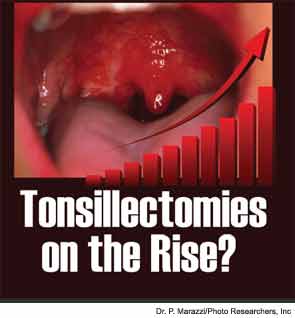
Explore This Issue
November 2012Are tonsillectomies on the rise? It’s a question that otolaryngologists have pondered in the wake of a recent article published in the Journal of Pediatrics that showed geographic and socioeconomic variation in the number of tonsillectomies performed (J Pediatr. 2012;160(5):814-819).
Over the years, indications for the 3,000-year-old procedure have shifted and tracking methods have evolved, and, as a result, any change in the rate of tonsillectomy should be viewed in light of these variables. Additionally, “individual provider decisions and patient needs will cause some variation in care across the United States,” with children covered under privately funded insurance perhaps more likely to undergo the procedure than their counterparts on Medicaid, said Emily F. Boss, MD, MPH, the article’s lead author and an assistant professor in the pediatric otolaryngology division at The Johns Hopkins University School of Medicine in Baltimore. Meanwhile, “tonsillectomy in the outpatient setting has definitely increased,” she said.
The study shows the marked patient and geographic variation in the use of tonsillectomies, said David Goodman, MD, MS, professor of pediatrics at The Dartmouth Institute for Health Policy and Clinical Practice at Geisel School of Medicine at Dartmouth in Hanover, N.H. “Previous studies show that a substantial proportion of regional variation reflects differences in provider practice patterns not explained by patient needs or preferences. This problem is compounded by the slow pace of clinical research,” he said. “Seventy-five years after Glover published his seminal study of tonsillectomy in school aged-children in England, we still have insufficient information on the short- and long-term outcomes of the medical and surgical therapies” (Pro Royal Soc Med. 1938;31:95-112).
Further, analyzing the statistics is complicated. The tracking methodology may account for at least some of the apparent increase in tonsillectomy, said Craig Derkay, MD, FACS, FAAP, professor and vice chairman of otolaryngology at Eastern Virginia Medical School and director of pediatric otolaryngology at Children’s Hospital of the King’s Daughters in Norfolk, Va. The procedure used to be performed mainly in hospitals, which provided data to the National Health Interview Survey. Now, with the inclusion of tonsillectomies performed at ambulatory surgical centers, “it may look like there are more being done, but we’re really counting them better,” Dr. Derkay said. “We’re capturing them all.”
Leave a Reply